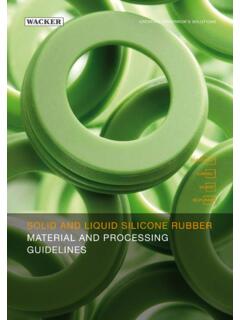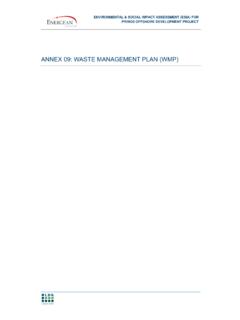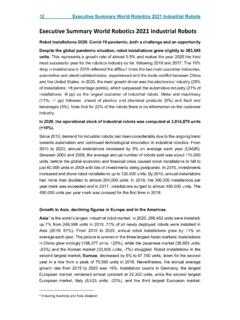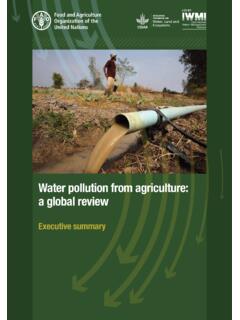Transcription of Silicones - Compunds and Properties - Wacker Chemie
1 Creating tomorrow s solutionselastomers, PlastiCs & ComPositessiliConesCompounds and PropertiessiliCones a world of unlimited PossibilitiesContentIntroduction 4 The Element Silicon 5 The Structure of Silicones 7 Silicone Applications 10 Pyrogenic Silica 12 Organofunctional Silanes 13 Silicone Fluids 14 Silicone Release Agents 15 Silicone Antifoam Agents 16 Silicone Textile Finishes 17 Silicone Rubber Compounds 18 Silicone Masonry Protection Agents 22 Silicone Resins 23 The History of Silicones 24 Silicones and Innovations 26 Science and Awards 28 Wacker at a Glance 31 ELASTOSIL and HDK are registered trademarks of
2 Wacker Chemie are truly jacks of all trades, capable of standing up to the toughest of requirements. Modern life would be inconceivable without Silicones . And, thanks to the freedom for design-ing the silicone molecule, there are countless future applications still to encounter Silicones every day, though we hardly every notice them. Under the hood, silicone rubber protects the car electronics against moisture and dirt; in car lacquers silicone additives provide gloss; in washing machines, silicone antifoam agents prevent the detergent from foaming over; in shampoo they give hair its sheen.
3 They provide woolen gar-ments with a typical soft hand, and, as silicone resin emulsion paints, they give masonry water repellency, while allowing water vapor and carbon dioxide to dif-fuse out of its also perform superbly in medi-cal applications, where high resistance or a state-of-the-art product is required: as a highly pure material for medical tubes, plasters or orthopedic products, as a reliable sealant and insulating mate-rial in electrical equipment or insulators. Pyrogenic silica is also used as a thick-ening additive in adhesives for the rotor blades of wind outstanding versatility is the result of silicone chemistry: Silicones are modern synthetic products based on a raw material, quartz sand, which is avail-able in practically unlimited quantities.
4 Their versatile performance is due to the chemical structure and the many differ-ent ways it can be modified. As a result, Silicones can be provided with tailor-made Properties that are fascinating and offer continually new possibilities. On the following pages, let us guide you through the world of Silicones . Discover the unique chemical and physical prop-erties, and gain insights into the versatile applications they open Can be found eVerYwHere4from raw material to tHe ProduCt worldThe chemistry of silicon and its compounds is extremely dynamic. Hardly any technology in recent decades has shaped technical progress so strikingly as silicon chemistry.
5 This success story begins with the element Facts In nature, silicon occurs exclusively in oxidized form, as the compounds silicon dioxide and silicates. Silicon is the second commonest element in the Earth s solid crust, accounting for percent by weight, and the most important compo-nent of inorganic materials. Since silicon is very rarely found as an element in nature, it was not isolated until relatively recently. On the other hand, siliceous construction and engineering materials, such as sand, clay and ceramics, have been available since time Chemistry is Very EfficientIn 1940/41, Professors M ller and Rochow independently discovered how to react silicone with methyl chloride gas (CH3Cl) to form liquid methylchloro-silanes.
6 This step provided the starting materials for the industrial manufacturing of Silicones and launched a global boom in silicone production. Based on the pio-neering work of Dr. Siegfried Nietzsche, Wacker , in 1947, became the first european company to start researching the field. In the following years, Wacker processes laid the cornerstone for the modern and efficient manufacturing of organochlorosilanes and silicone products. This was the beginning of the success story. These early scientific accomplish-ments underlie Wacker s reputation as the european pioneer of silicone chem-istry.
7 Now globally active, the Group uses complex chemical processes to manu-facture versatile product classes such as silicone fluids, resins or elastomer SilicatesPyrogenic SilicaSilicone Fluids and EmulsionsMasonry Protective AgentsAntifoamAgentPaper CoatingMaterialLiquis SiliconeRubber GradesRTV-2 RubbersRubber CompoundsPolymersResinsOrganofunctional SiloxanesOrganofunctional SilanesSilicone FluidsMold-Release AgentsTextile FinishesSilicone RubberCompoundsRTV-1 SealantsHydrolysisTetrachlorosilaneSilic onCrude Silane MixtureSilane DestillationM ller-Rochow MethodCoalElectric FurnaceSandMethylchlorosilanesReactorThe production scheme for Wacker silicones6 HigHlY fleXible elementarY building bloCKsSilicones.
8 Silanes and the various siloxane units a few words about terminology, classification and Term Silicone The term silicone was coined by F. S. Kipping (1863-1949), and refers to the formal analogy between these silicon compounds and the equivalent oxygen compounds of carbon (poly-silicoketones). However, the Si-O-Si group is better described by the term siloxane. Strictly speaking, therefore, all Silicones should correctly be termed polysiloxanes. Nowadays, the term silicone is principally used in conjunc-tion with the technical applications of polysiloxanes. Silanes are the Starting PointThe starting point and chief building blocks for silicone production are silanes.
9 Silanes are produced by direct synthesis from silicon and methyl chloride (M ller Rochow synthesis). They are colorless, clear, mobile liquids that are soluble in organic solvents including anhydrous alcohol in certain cases. The low mole-cular mass of silanes makes them highly Silicone StructureSilicones, known to chemists as polydio-rganosiloxanes, have a structure that resembles quartz modified with organic groups. They consist of an inorganic backbone built up of alternating silicon and oxygen atoms. The other two bonds of the silicon atoms are occupied with organic groups (preferably methyls), which are responsible for Silicones semi-organic figure illustrates the typical structure of a linear silicone polymer (polydimeth-ylsiloxane).
10 The nonpolar methyl groups can rotate freely around the silicon-oxygen chain, forming a shield for the polar main chain. The shielding explains the low surface tension and high spreading power that make Silicones ideally suited for use as efficient hydrophobizing chemists distinguish bet-ween four different structural units:Monofunctional units permit chain units form the backbone of macromolecular chains and ring units produce branched molecules and form the basis of units lead to crosslinked structures similar to Monofunctional unitsSiORRRSiORRSiOROOOSiOOOO Difunctional unitsSiORRRSiORRSiOROOOSiOOOO Trifunctional unitsSiORRRSiORRSiOROOOSiOOOO Tetrafunctional unitsstruCtural VarietY as a formula for suCCess8 SiOCH3CH3 SiSiSiSiOOOCH3CH3CH3CH3CH3CH3CH3CH3 OOSiClCH3CH3 ClOCH3CH3 SiOCH3 OSiOCH3 OSiCH3CH3 SiCH3 SiCH3CH3CH3 OChemical structure of a linear silicone polymer (polydimethylsiloxane)










